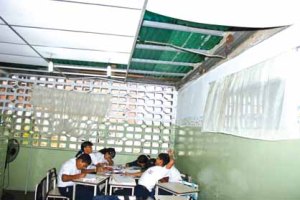The educational policy deficit

We can do better than this school in La Pastora
As the Hugo Chávez era comes to a close in Venezuela, it is time to begin taking stock of his legacy.
One of the oft-repeated lines is that Chávez was “good for the poor.” Certainly, poverty statistics – as measured by the percentage of the population living below a certain income threshhold – have improved under his watch. One could easily be tempted to believe that this shows success.
But while this certainly helps explain Chávez’s continued dominance at the polls, it is not enough to conclude that poverty has been abated in the medium run. Real poverty abatement – the kind of long-lasting generational shift in income levels that we saw in places such as Japan and South Korea in 1950-1990, or that we see in China today – comes from improved productivity, and one of the keys to achieving this is education.
Ah, chavistas will say, in education we also show marked improvements: why, just look at all the money we spend on Misiones. More kids go to school now than ever before!
This is all a mirage.
The other day I went to a conference where one of the speakers was José Piñera, one of the ideologues of many of Chile’s most succesful (or, some would say, horrific) economic reforms. Regardless of how you feel about him, Piñera threw out a line that stuck with me, and it is applicable to the chavista context.
“Loans, credits, spending on education,” he said, “this is not educational policy, it is social policy. Real educational policy comes from changes in content, from curricular reform, from looking at teaching practices. Without that, we cannot discuss educational policy.”
In other words, real education reform has more to do with quality than quantity. Reral education reform consists of increasing productivity so that people can achieve higher income levels on their own.
If we accept this definition, can we then say there has been serious educational reform under Hugo Chávez?
Hardly.
While there have been efforts to change the curriculum, most of it has been either harmful or irrelevant. Competition among students and performance evaluation have been hampered. Parental involvement in schools has been watered down. Content has been skewed to better reflect political indoctrination. Teaching of English has taken a back seat.
Aside from the Canaima program, whereby kids get laptops, has there been any serious effort to integrate technological content in our schools to improve productivity? Have there been any efforts at all to lower the student-to-teacher ratio, to bring about new pedagogical approaches, or to provide kids an environment where they can experiment or learn a trade?
I mean, if it takes a blog to equip poor school shops with tools, you know something isn’t working.
What about Misiones that purportedly help people finally earn their degrees? Has there been any assessment of, say, Misión Ribas’ effects on wages?
You know the answer to all these questions. Deep down, Hugo Chávez’s “educational” policy is simply social policy, tantamount to getting on a helicopter and throwing dollar bills – or cheap laptops – at poor parents, borrowed at credit card interest rates.
(Note: I’m really, really making an effort to stop talking about Chávez’s illness. I am pretty sick of the topic and we’re not even done with it yet. Last week’s “Diosdado and Maduro vs. the Constitution” Celebrity Death Match left me depressed and exhausted, and it’s only going to get more intense as nature continues its course. So, if you’ll excuse me, I’m sticking to more wonky-type posts in the next few days, unless and until something dramatic happens … )
Caracas Chronicles is 100% reader-supported.
We’ve been able to hang on for 22 years in one of the craziest media landscapes in the world. We’ve seen different media outlets in Venezuela (and abroad) closing shop, something we’re looking to avoid at all costs. Your collaboration goes a long way in helping us weather the storm.
Donate




